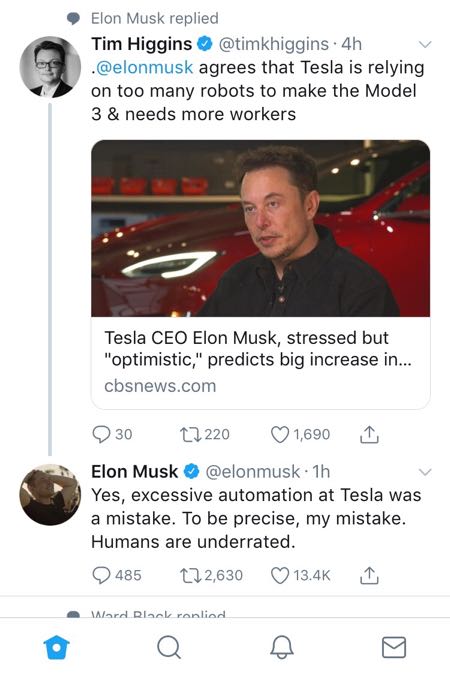This exchange was a great example of how humans and technology work together and how that interaction can change over time to become more effective.
Just ask Elon Musk. Production of the Tesla Model 3 is behind schedule so not only has Elon Musk taken to sleeping on the production floor, he recently tweeted this:

Was Tesla ill advised to build production processes dependent on robotics? Of course not.
Is Tesla ill advised in re-evaluating and elevating the role of people in the factory? Of course not.
Whether software (i.e. commodity price forecasting software) or hardware (i.e. robotics in the packing plant), throwing more technology at a problem isn’t a silver bullet solution. But neither is throwing more people at a problem.
A TechCrunch article explains this dynamic brilliantly:
“The evolution of human tools, from rocks to AI, can be seen as a trajectory of increasingly powerful effort arbitrage, where we exploit our comparative advantage relative to our tools to do things better, and do more new things.
“In this pursuit of effort arbitrage, the smallest of intelligence advancements has the power to yield enormous gains for humans, individual and collective. A seemingly simple change 2.5 million years ago — using stone tools to butcher animals — led early hominids down the path to becoming modern humans.
“From that modest starting point, throughout human history, we created tools that increased our individual and collective intelligence and became extensions of our natural selves. We started with crude functional tools such as hammers and axes. Over just a few tens of thousands of years, we progressed to more intelligent tools, such as thermostats, and governance technologies based on rule-of-law rather than despotism.
“Our tools could begin doing bigger and bigger things on our behalf, freeing us up for other, more desired tasks. This progression has continued. We’re at an interesting transition point where we are moving from using our tools as passive extensions of ourselves, to working with them as active partners.”
Savvy leaders think human intelligence PLUS artificial intelligence.
Laggards think human intelligence versus artificial intelligence.
Savvy leaders see the opportunity for effort arbitrage. To combine human intelligence and artificial intelligence in increasingly new ways that create competitive advantage.
Savvy, forward thinking leaders look at their business to find the right ways to incorporate technology to make people more effective; they’re always evaluating this equation:
Humans + Technology = Business Outcomes
And they know this isn’t 1+1=2, it’s 1+1=5 if done right.
Getting the equation right requires continual calibration by asking the following questions:
- How will we measure success of this system?
- What capabilities are needed in the people who interact with the technology?
- What capabilities are needed in the technology that interacts with people?
- Is the interaction between people and technology accretive and generating better results than either could achieve on their own?
- How are capabilities and results improving over time?
In meat, milk & eggs businesses where technology plays an increasing role, these questions are critical. How are you combining human intelligence with artificial intelligence to realize better business results?
This article was originally published on Meatingplace.









